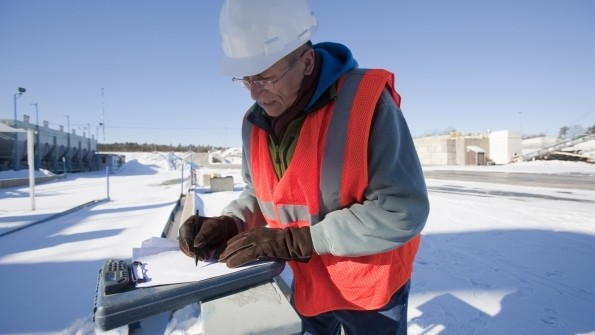This time of year, cold stress that can result in hypothermia or frostbite is a hazard of which employers must be aware, particularly if they have outdoor workers. With the right preparation and presence of mind, both employers and employees can prevent these injuries.
One of the most effective prevention techniques is adopting the attitude that safety is an area of responsibility for everyone in the organization – both the employer and workers. Companies must initiate and reinforce safety protocols and clearly spell out safety responsibilities and expectations.
Including your staff in all aspects of your safety plan – from hazard identification to problem solving – not only will encourage a strong safety culture within your organization, it also will allow for an open dialogue that leads to continuous improvement. This includes seasonal safety policies.
Slips, Trips and Falls
The Bureau of Labor Statistics recently announced that slips, trips and falls accounted for 800 workplace fatalities in 2015 at a time when workplace deaths in the U.S. reached a six-year high.
Slips, trips and falls happen year-round, of course, but winter ice and snow create a more hazardous environment that increases the risk of worker injuries.
A proactive safety plan that specifically addresses slips, trips and falls not only enhances worker safety but also minimizes potential costs from workers’ compensation payments, government fines or equipment/facility remediation requirements.
No shortage of information exists on safety measures to reduce slip, trip and fall incidents, and your insurance carrier may have specific suggestions pertaining to your facility.
For employers, an active effort needs to be made to prevent ice build-up on walkways, de-icing walkways and clearing walkways. Parking areas and outside break areas are often the most commonly overlooked.
Snow removal companies often allow snow and other debris to build up in areas which directly are in employees’ pathways or otherwise obstruct a safe pathway.
The parking lot needs to be addressed as many winter falls occur when someone is getting in/out of his/her car or walking toward a cleared sidewalk.
This oversight, or simply the reliance on de-icing efforts alone, creates more potential hazards. In other words, there needs to be eyes on the parking areas, outside break areas and walkways at all times.
Here are six simple tips to avoid slips, trips and falls during the winter season:
- Keep walkways, stairways and other work areas clear.
- Remove hazards, such as water on floors and snow on sidewalks, immediately.
- When walking, look where you are going and have your hands ready to steady yourself should you slip.
- Avoid carrying heavy loads that may compromise your balance.
- Mark hazardous areas. Use temporary signs, cones, barricades or floor stands to warn passing workers.
- Outside, wear footwear with heavy treads for increased traction. Walk along grassy areas if a walkway is covered in ice. Make yourself visible to drivers by wearing a brightly colored jacket or clothes.
Frostbite and Hypothermia
Frostbite and hypothermia are the consequences of cold exposure, and both can have long-lasting effects. If you suspect either condition, call for help.
Know the signs of hypothermia and frostbite:
Hypothermia
- Shivering or shaking
- Lack of coordination
- Drowsiness or confusion
- Slurred speech
Frostbite
- Skin that is very cold and turns numb, hard and pale
- Blisters or swelling
- Joint or muscle stiffness
Keep the affected body part elevated in order to reduce swelling, and move the person to a warm area to prevent further heat loss. Remove all wet clothing and apply a dry, sterile bandage to the affected area or place cotton between any involved fingers or toes. Seek proper medical care as soon as possible.
Read more at EHSToday.com




